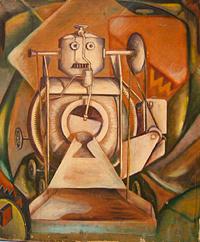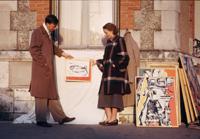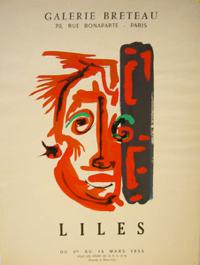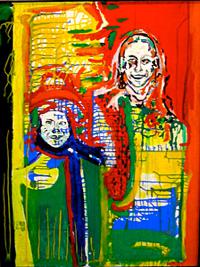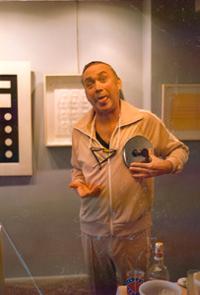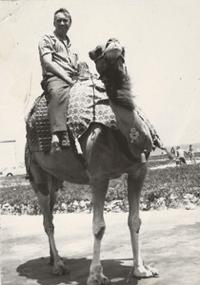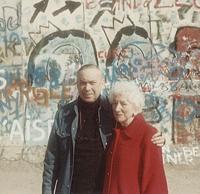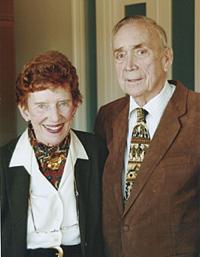Raeford Liles Biography
Early Years
Liles is born in Birmingham, Alabama in 1923, the third of four sons. His father works for the telephone company and dies when Liles is 14; his mother sells their AT&T stock to support the family. Liles attends Birmingham Southern College from 1941-43 and then, following a long family tradition of military service, enlists in the Navy, just before his 20th birthday. Serving as a Navy fighter pilot on the aircraft carrier USS Essex, Liles is one of only a few of his squadron to return from the war.
He returns to Birmingham Southern College in 1946 and then transfers to Auburn University, graduating in 1949 with a BS in Electrical Engineering and a Minor in Fine Art. At Auburn Liles studies art with noted artists Basil Cimino (American, 1913–1966) and Maltby Sykes (American, 1911-1992). Working primarily in watercolor and oil, his early work is influenced by Cubism, Surrealism, and modern Expressionism.
France
In 1949 Liles marries Elsa Allgood in Birmingham. Like many young artists at the time, they travel to Europe, living in France until 1957. In Paris from 1949-51, Liles studies at Atlelier Fernand Leger on the GI Bill. They live in Montmartre as expatriates his wife supporting them as Liles paints. At first Liles' work is derivative, as he experiments with Cubism and Expressionism. But Liles quickly arrives at a unique style that incorporates the energy of Abstract Expressionism, the spontaneity of Action paintings, and an intense sensibility of color and emotion.
In 1951, Liles and his wife move to Orleans, south of Paris, where Elsa works as a secretary at the headquarters of the U.S. Army. Liles, no longer a student, begins his career in earnest, working in series of still lifes and landscapes, with each painting an abstract study in color and composition. Vivid and fluid, color dominates them all. He has his first show at Galerie 8 in Paris, in 1951.
Returning to Paris, in 1953, Liles settles into a period of intense creativity. Working during the day for the US Army as an engineer, he paints at night. A series he calls, "Artisans", consists of portraits of people working, such as a baker, a seamstress, a streetwalker. Another group portrays his own war experience and that of his brother as a POW in Korea. The work is vibrant and emotionally intense.
In 1954 Liles' first daughter is born. He has a show at Galerie Breteau, Paris in 1955 and another in Helsinki, Finland in 1956, shortly before his second daughter is born. That year, in addition to working with acrylic on canvas, Liles creates a series of spontaneous paintings using spray paint on paper, creating hundreds of images after coming home from his day job. This work is a diary of expressionist experimentation. His use of metallic and spray paint anticipates aspects of graffiti art of the 1980s.
In 1957, suffering from mental stress, Liles has a breakdown, returns to the United States and is treated at a VA hospital in Tuscaloosa, Alabama. Discharged, he is employed by the Department of Defense as a civilian engineer at Airforce bases being decommissioned. He and Elsa divorce in 1959. In 1961 he retires from Civil Service with a medical disability.
New York
Liles moves to New York City in 1961, settling into a one-room studio in Hell's Kitchen. He works at a local bar and begins painting seriously. He paints a portrait of his daughters and creates a series of large, highly evocative paintings protesting war. Socializing with other artists, he meets art critic, Charles Giuliano and writer, Moria Hodson (NY Times food writer). He works with Moira creating cookbooks and shows "Angry Art" at East Hampton Gallery in 1967. His work extends to embrace civil rights and anti-war riots. The works are not critically well received; considered too shocking and emotionally charged for the times.
In the 1970s, Liles volunteers at the New York City Ballet and begins painting his Ballet series using tape, florescent spray paint and the resist shapes of found objects as stencil graffiti. He has a number of solo shows of this work, one at the Birmingham Museum of Art. In the mid 70s, Liles meets Silvia Pizitz, a modern art collector, originally from Birmingham. They begin a long-term relationship that will last over 25 years. Together they travel extensively around the world and finally marry in 1989. Their travels inspire a series of collages based on Greek pots and Egyptian art.
In the 1980's, inspired by Silvia's collection of minimalist art, Liles begins work on sculptures made from Legos and acrylic. This and the Ballet series are shown in New York in solo and group exhibitions around the country. In the late 1980s, there is a major flood in Silvia's basement, which destroys much of the Greek and Egyptian work. Liles recreates many of the images. While revisiting the Greek work, he becomes inspired by erotic Greek imagery and his work becomes explicitly erotic. Liles continues his collage work with a series based on Asian erotica, Hindu sculptures and Chinese love poems. These works and the 80s plastic Lego sculptures are exhibited in one-man shows in New York. Silvia Pizitz dies in January 1991.
Two years later, Liles marries Virginia Pitts Rembert, artist, author and Art History Professor emeritus at the University of Alabama, also originally from Birmingham. They move to Manhattan's Upper West Side and also travel extensively. Liles continues to work in collage and begins writing his memoirs.
Birmingham
In 2005, Raeford and Virginia leave NYC and retire to Birmingham, Alabama where they take an active role in the arts and work on their memoirs. In 2007, Liles has a retrospective show of his artwork from the 1950s to the present at the Jennifer Harwell Gallery. He and Virginia settle in a retirement community near Birmingham. After a short illness, Virginia dies in the summer of 2013.
Raeford moves to a VA home in Alabama, where, with the help of aides, he continues to paint. A number of his paintings are accepted into the collections of The Birmingham Civil Rights Institute, The Georgia Museum of Art and The Jule Collins Smith Museum. In 2016, Art History students at Auburn University curate a retrospective show of his work. He dies in June, 2018, a month shy of 95. Instead of a memorial service, he asked for a party with friends, good food and champagne.


